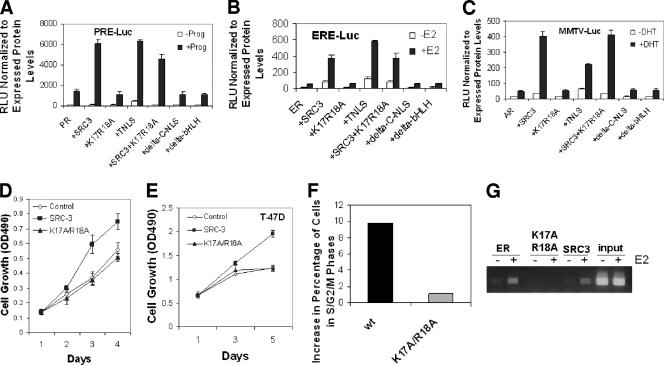FIG. 6.
Effects of SRC-3 mutants on receptor-dependent luciferase reporters and cancer cell growth. (A) Luciferase assays using PRE-luc. HeLa cells were transfected with PR and PRE-luc either alone or together with SRC-3 wt (+SRC3), its K17A/R18A mutant (+K17R18A), the TNLS fusion with this mutant (+TNLS), combined SRC-3 and K17R18A (+SRC3+K17R18A), deletion of C-NLS (+delta-C-NLS), or deletion of bHLH (+delta-bHLH), followed by treatment with (+Prog) or without (−Prog) progesterone and analyses of relative luciferase activities (RLU) normalized to expressed protein levels. (B) The procedure was the same as that described for panel A, except that ER, ERE-luc, and hormone estrogen (E2) were used. (C) The procedure was the same as that described for panel A, except that AR, MMTV-luc, and hormone DHT were used. (D) Effect of SRC-3 wt and its K17A/R18A mutant on 293 cell growth. Equal numbers of 293 host cells (Control) and tetracycline-inducible 293 cells expressing SRC-3 wt (SRC-3) or its K17A/R18A mutant (K17A/R18A) were seeded into 96-well plates. One day after induction with tetracycline, cell proliferation was determined as described in Materials and Methods. OD490, optical density at 490 nm. (E) T47D breast cancer cells overexpressing SRC-3 wt or its cytoplasmic mutant (see Materials and Methods) were examined for cell growth using the method described for panel D. (F) Cell cycle analysis of cells described for panel E. Increases in percentage of cells in S/G2/M phases were analyzed for SRC-3 wt or its mutant (see Materials and Methods). (G) ChIP analysis of cells described for panel E. Recruitments of ER, SRC-3 wt, or its cytoplasmic mutant on the pS2 promoter were examined.

